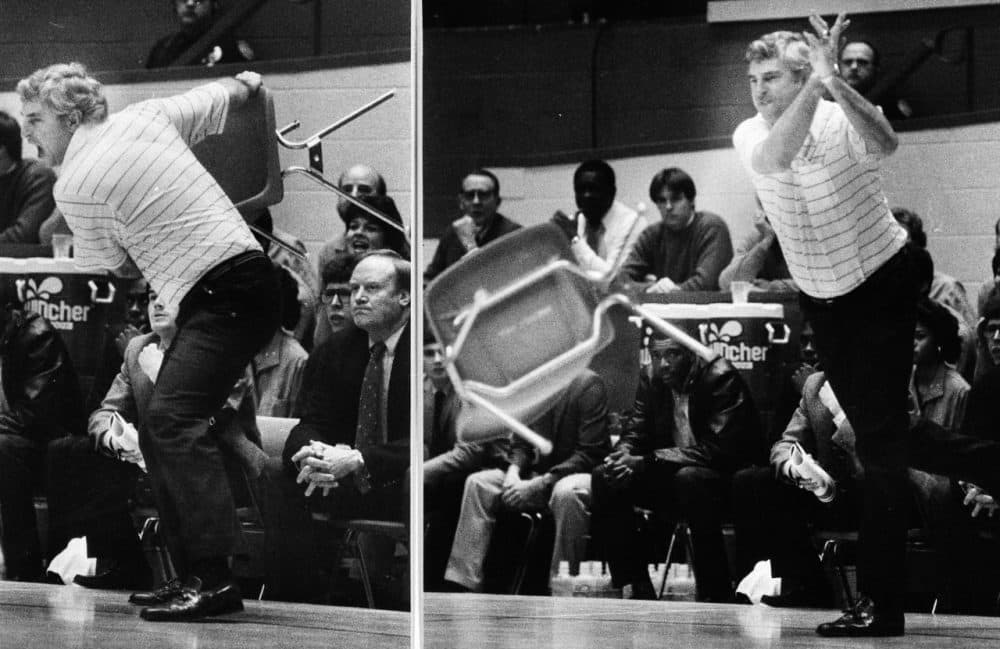Advertisement
Where In The World Is Bob Knight's Chair?
Resume
This column was originally published in the Indy Star on June 28, 2015.
It's behind this door. That's what I've been told. It's a chair, red molded plastic on cheap metal legs, and it wouldn't fetch two bucks at a garage sale unless it was this chair, the chair, the one Bob Knight threw across the court in 1985 against Purdue.
The chair is stored deep inside Assembly Hall, and I'm thinking this chair -- the chair — deserves better. Better than this. An anonymous door, black metal, unmarked and unremarkable.
Treasure, buried in an unmarked grave.
"This is it," Indiana University Facilities Director Chuck Crabb says as he pushes open the door.
It's warm in here, musty, just concrete for floor and cinder blocks for walls and eight light bulbs hanging from the ceiling. Seven lights work.
"This is a machine room," he says. "A switch-gear room."
This is an unworthy room.
Because that's the most famous chair in college basketball history.
It was Feb. 23, 1985. Indiana was 14-9 — and heading for the NIT — and the referees were not having a great day. Five minutes into the game, Steve Alford dove for a loose ball, tied up a Purdue player and was called for a foul. Seconds later, Daryl Thomas was called for a ticky-tack foul in the post.
Bob Knight was yelling at referee Fred Jaspers, who came over to warn him. Knight sat down, muttering, and Jaspers heard him. Whistle. Technical.
Bedlam at Assembly Hall.
Knight grabbed a chair from his bench and threw it onto the floor. It skidded past Reid toward the corner, veering into the photographers sitting on the baseline. Knight was ejected. He walked out to the thunderous sound of "Bob-by, Bob-by." Reid was given six technical free throws, but the thunder undid the Big Ten's leading foul shooter; he missed three of six.
What happened next to the chair? Lots of people think they know. Lots of people are wrong.
"Stories about the chair are many," Crabb is telling me as we stare at the chair inside that warm, dingy machine room. Or maybe we're not looking at the chair. The chair could be in that stack. It could be gone. Nobody knows.
Not even the guy who paid $8,000 for it in 2003 while visiting the Nevada governor's mansion.
"A handful of people think they really have it," Crabb says. "So many people over the years have mentioned it to me on emails or on Facebook: 'I have the chair.'"
Do you? Really?
Here's what Crabb knows about the chair, and this is all he knows.
"After the chair went across the court, a manager picked it up and took it away. Later that day, the chairs were set on a rack and wheeled away," he says.
Wait. So you're telling me the chair — sorry, the chair — is unaccounted for?
"It's like the ending to Indiana Jones," Crabb says. "The Ark of the Covenant is on one of those crates in a giant warehouse. But which crate? Nobody knows."
How many people have come looking for the chair?
"You're the first," Crabb says.
When Assembly Hall opened in 1971, IU ordered 100 red molded plastic chairs to serve as team benches and to fill the gaps next to the bleachers.
"People, maybe workers, bring friends into the building and they find themselves here in this room," Crabb says. "'Hey, what do you know? There's the chairs.' And one goes missing."
You're saying there are just 16 chairs left — 16 out of 100 — because some broke and the rest were stolen?
"Not stolen," Crabb says, smiling. "Procured."
If this is how it ends, it's a sad finish for such a famous chair. Cable and electrical wires cover the walls like kudzu. A steel ladder is on the floor.
"That's a lot of juice you're looking at there," Crabb says, and I suppose he's looking at the electrical switches. I'm looking at 16 red molded plastic chairs. I'm looking for scratches, any sign that this is the chair that skidded across Assembly Hall and into college basketball legend. I'm looking for greatness, for history.
But I'm seeing red molded plastic chairs, the kind you'd buy for $2 at a garage sale and wonder if you were ripped off.
To read the entirety of Gregg Doyel's column "Quest for a legendary relic — Bob Knight's chair," click here.
This was the first in a new feature we're trying out that celebrates great sports writing of the short-form variety. We're thinking of calling it "Radio Playbook" or maybe "Column Like You See 'Em". Have a better name in mind? Let us know.
This segment aired on May 14, 2016.
